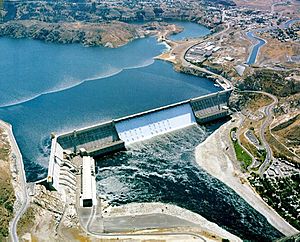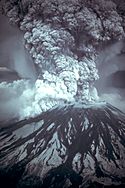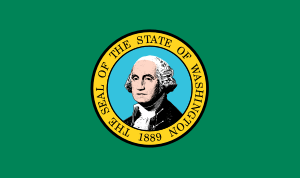History of Washington (state) facts for kids
The history of Washington state includes thousands of years of Native American life before Europeans arrived. Europeans then began to claim the land. The region was part of Oregon Territory from 1848 to 1853. After that, it became Washington Territory thanks to efforts at the Monticello Convention. On November 11, 1889, Washington officially became the 42nd state of the United States.
Contents
Ancient Times and Early Cultures
Archaeologists have found signs that the Pacific Northwest was one of the first places in North America where people lived. Bones of animals and humans, dating back 13,000 years, have been found across Washington. Evidence of people living in the Olympic Peninsula goes back to about 9,000 BCE. This was thousands of years after huge floods of the Columbia River created the Columbia Gorge.
Experts believe there were 125 different Native American tribes and 50 languages or dialects in this region before Europeans arrived. Along the Puget Sound, coastal tribes used the area's rich natural resources. They mainly ate salmon, halibut, shellfish, and whale. Cedar trees were very important for building. Tribes used cedar to build longhouses and large canoes. They even made clothes from cedar bark.
The tribes along the Columbia River became the wealthiest in Washington. This was because they controlled Celilo Falls, which was the best salmon fishing spot in the Northwest. Millions of salmon passed through these falls on the Columbia River to lay their eggs. Among the coastal tribes, women often became important traders, while men took part in battles and captured people from other tribes. The eastern tribes, known as the Plateau tribes, survived by hunting, fishing, and gathering food during different seasons. Both men and women shared equal responsibility for finding food among the Plateau Indians.
Some of the main coastal tribes included the Chinook, Lummi, Quinault, Makah, Quileute, and Snohomish. The Plateau tribes included the Klickitat, Cayuse, Nez Percé, Okanogan, Palouse, Spokane, Wenatchee, and Yakama. Today, Washington has more than 20 Indian reservations. The largest one belongs to the Yakama tribe.
At Ozette, in the northwest part of the state, an ancient village was buried by a mudslide about 500 years ago. More than 50,000 well-preserved items have been found there. Many of these are now shown at the Makah Cultural and Research Center in Neah Bay. Other sites also show how long people have lived in this area. Small quartz knife blades found at the Hoko River site near Clallam Bay are believed to be 2,500 years old.
European and American Arrival
Early Explorers and Claims
The first European to record landing on the Washington coast was Juan Pérez from Spain in 1774. A year later, Spanish Captain Bruno de Heceta landed near the Quinault River mouth. He claimed the coastal lands for Spain.
In 1778, British explorer Captain James Cook saw Cape Flattery, which is at the entrance to the Strait of Juan de Fuca. But the strait itself was not found until 1787 by Charles William Barkley. He named it after Juan de Fuca. In the 1790s, agreements between Spain and Britain, called the Nootka Conventions, ended Spain's sole control. This opened the Northwest Coast to explorers and traders from other countries, especially Britain, Russia, and the United States.
Spanish explorers Manuel Quimper (1790) and Francisco de Eliza (1791) explored the straits further. Then, British Captain George Vancouver explored in 1792. Captain Vancouver claimed the sound for Britain. He named the waters south of the Tacoma Narrows "Puget's Sound" to honor Peter Puget, who was with him. This name later included the waters north of Tacoma Narrows too. Vancouver and his team mapped Washington's coast from 1792 to 1794.
Captain Robert Gray discovered the mouth of the Columbia River in 1792. He named the river after his ship, the "Columbia." He later started trading sea otter furs. The Lewis and Clark Expedition, led by Meriwether Lewis and William Clark, entered the state from the east on October 10, 1805. They were surprised by how different the Native American tribes were in the Pacific Northwest compared to others they had met. They especially noticed the higher status of women among both coastal and plateau tribes.
Canadian explorer David Thompson explored the Columbia River a lot starting in 1807. In 1811, he became the first European to travel the entire length of the river to the Pacific Ocean. Along the way, he put up a sign where the Columbia joins the Snake River. This sign claimed the land for Britain. It also said that the North West Company planned to build a fort there. Later, the Fort Nez Percés trading post was built near what is now Walla Walla, Washington.
Before white women began moving to the territory in the 1830s, Métis women were often sought as wives for traders. Métis people are of mixed European and Native American heritage.
Land Disputes Between Nations
American interest in the region grew as part of the idea of Manifest Destiny. This was a belief that the United States was meant to expand across North America. Spain gave up its claims north of the 42nd Parallel to the United States in the 1819 Adams–Onís Treaty.
Britain had long-standing business interests through the Hudson's Bay Company. They had many fur trading forts along the Columbia River in what they called the Columbia District. Their main base was Fort Vancouver in present-day Vancouver, Washington.
By the Treaty of 1818, Britain and the United States set the 49th parallel as the border west to the Continental Divide of the Rocky Mountains. But they agreed to share control and use of the Oregon Country. In 1824, Russia signed an agreement with the U.S., saying it had no claims south of 54-40 latitude north. Russia signed a similar treaty with Britain in 1825.
Sharing the land was renewed yearly in 1827. But tensions grew between U.S. settlers arriving by the Oregon Trail and fur traders. This led to the Oregon boundary dispute. On June 15, 1846, Britain gave up its claims to lands south of the 49th parallel. The U.S. gave up its claims north of that line, which is now the Canada–US border, in the Oregon Treaty.
In 1848, the Oregon Territory was created. It included present-day Washington, Oregon, and Idaho, plus parts of Montana and Wyoming. Washington Territory, which included Washington and parts of Idaho and Montana, was formed from Oregon Territory in 1853. In 1872, a process settled the border dispute from the Pig War. This set the US–Canada border through the San Juan Islands and Gulf Islands.
Early American Settlements
Eastern Washington Settlements
Settlements in eastern Washington were mostly farms. They grew around missionary places in the Walla Walla Valley. Missionaries tried to change the Native Americans' ways of life. This often ignored or misunderstood native customs. In 1847, missionaries Dr. Marcus Whitman and Narcissa Whitman refused to leave their mission as tensions grew. Fourteen American missionaries were killed by Cayuse and Umatilla Indians. This event, known as the Whitman massacre, happened due to disease outbreaks, anger over harsh attempts to change their religion and way of life, and disrespect shown by the missionaries.
This event started the Cayuse War against the Native Americans, followed by the Yakima War. These wars lasted until 1858. The Provisional Legislature of Oregon quickly sent volunteers to fight the Cayuse. The United States Army later supported these forces. In 1850, five Cayuse were found guilty of killing the Whitmans and were hanged. Fighting continued until 1855. The Cayuse were defeated and lost their tribal lands. They were then moved to the Umatilla Indian Reservation in northeastern Oregon.
Conflicts over land between Native Americans and American settlers led to new agreements in 1855. At the Walla Walla Council, the Americans forced the Cayuse, Walla Walla, and Umatilla tribes onto the Umatilla Indian Reservation. Fourteen other tribal groups were moved to the Yakama Indian Reservation in southern Washington. The Nez Perce were moved to a reservation in the border region of Washington, Oregon, and Idaho. That same year, gold was found in the new Yakama reservation. White miners then entered these lands. The tribes, first the Yakama, then joined by the Walla Walla and Cayuse, united to fight the Americans in the Yakima War. The U.S. Army sent troops, and many battles took place. In 1858, the Americans won a major victory at the Battle of Four Lakes. In a new agreement, tribes were again confined to reservations.
Puget Sound Settlements
As American settlers moved west on the Oregon Trail, some traveled north into the Puget Sound area. The first settlement in the Puget Sound area was Fort Nisqually. This was a farm and fur-trading post owned by the Pugets Sound Agricultural Company. Washington's pioneer founder, Michael Simmons, along with George Washington Bush and his wife, Isabella James Bush, settled New Market (now Tumwater) in 1846. They settled in Washington to avoid Oregon's unfair settlement laws. Many more settlers followed, moving north along the Oregon Trail to the Puget Sound area.
Compared to other American settlements in the West, there was less violence between settlers and Native Americans here. However, there were conflicts like Territorial Governor Isaac Ingalls Stevens's efforts in 1853 to force Native Americans to give up lands. Major conflicts included the Puget Sound War, Cayuse War, Yakima War, and Spokane War. Raids by Haida, Tlingit, and other northern tribes from British and Russian territory also caused fear among Native Americans and settlers in Puget Sound in the 1850s.
Lumber industries attracted settlers to the territory. Coastal cities like Seattle (founded in 1851) were established. Unlike the wagon trains that brought whole families to Oregon, these early trading settlements mainly had single young men. The Fraser Canyon Gold Rush in British Columbia in 1858 brought a lot of settlement and business to northern Puget Sound. This led to the growth of Port Townsend and Whatcom (which became Bellingham) as trade centers.
When Oregon became a state in 1859, the eastern parts of the Oregon Territory were added to the Washington Territory. This included southern Idaho, parts of Wyoming, and a small part of Ravalli County, Montana. In 1863, the area of Washington Territory east of the Snake River was reorganized as part of the new Idaho Territory. This left Washington Territory with only the lands within its current state borders.
Becoming a State

After the Enabling Act of 1889 was passed, Washington became the 42nd state in the United States on November 11, 1889. The first proposed state constitution included women's suffrage (the right to vote for women) and prohibition (banning alcohol). However, both of these ideas were removed from the final accepted constitution. Women had been given the right to vote in 1883 by the Washington Territorial Legislature. But this right was taken away in 1887 because women supported prohibition. Despite these early setbacks, women in the Pacific Northwest gained the right to vote earlier than in other parts of the country. Washington passed a suffrage amendment in 1910. Prohibition followed in 1916, two years before it became a national law.
Early important industries in the state included farming, lumber, and mining. In eastern Washington, Spokane was a major center for mining. The Yakima Valley was known for its apple orchards and wheat fields. The heavy rain west of the Cascade Range created thick forests. Ports along Puget Sound grew rich from making and shipping lumber products, especially Douglas fir. By 1905, Washington State was the largest producer of lumber in the nation. Seattle was the main port for trade with Alaska. For a while, it also had a large shipbuilding industry. Other industries that grew in Washington included fishing, salmon canning, and mining. For a long time, Tacoma was known for its large smelters, where gold, silver, copper, and lead ores were processed. The area around eastern Puget Sound developed heavy industry during World War I and World War II. The Boeing Company became a famous company in the area.
Modern Washington
Mount St. Helens Eruption

On May 18, 1980, after a time of strong shaking and small eruptions, the northeast side of Mount St. Helens exploded. This destroyed a large part of the volcano's top. The eruption flattened forests for many miles. It killed 57 people. Ash and mud flooded the Columbia River and its smaller rivers. Large parts of Washington were covered in ash, making day look like night.
Washington's Economy Today
Washington is known for several big companies. The most famous ones include Microsoft, Amazon.com, Boeing, Nordstrom, and Starbucks.
Politics in Washington
Politics in Washington have generally favored the Democratic party since the 1950s and 60s. In 2004, voters elected Governor Christine Gregoire. This made Washington the first state to have a female governor and two female senators, Patty Murray and Maria Cantwell.
Protests against the World Trade Organization (WTO) happened in Seattle in 1999. These were sometimes called the "Battle of Seattle." They took place when the WTO met to talk about trade. Huge protests of at least 40,000 people included groups focused on environment issues, labor unions, student groups, and religious groups.
On January 30, 2006, Governor Christine Gregoire signed a law. This law made Washington the 17th state to protect gay and lesbian people from unfair treatment in housing, lending, and jobs. It was also the 7th state to offer these protections to transgender people.


